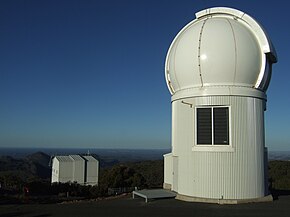 | |
| Part of | Siding Spring Observatory |
|---|---|
| Location(s) | New South Wales, AUS |
| Coordinates | 31°16′20″S 149°03′41″E / 31.27211°S 149.06129°E |
| Organization | Mount Stromlo Observatory |
| Altitude | 1,163 m (3,816 ft) |
| Wavelength | 325 nm (920 THz)–969 nm (309 THz) |
| Built | –November 2007 |
| First light | 2008 |
| Telescope style | Cassegrain reflector optical telescope |
| Diameter | 1.35 m (4 ft 5 in) |
| Secondary diameter | 0.69 m (2 ft 3 in) |
| Angular resolution | 1.1 arcsecond |
| Collecting area | 1.16 m2 (12.5 sq ft) |
| Focal length | 6.2 m (20 ft 4 in) |
| Mounting | altazimuth mount |
| Enclosure | dome |
| Website | www |
| | |
SkyMapper is a fully automated 1.35 m (4.4 ft) wide-angle optical telescope at Siding Spring Observatory in northern New South Wales, Australia. It is one of the telescopes of the Research School of Astronomy and Astrophysics of the Australian National University (ANU). The telescope has a compact modified Cassegrain design with a large 0.69 m secondary mirror, which gives it a very wide field of view: its single, dedicated instrument, a 268-million pixel imaging camera, can photograph 5.7 square degrees of sky. The camera has six light filters which span from ultraviolet to near infrared wavelengths.
The SkyMapper telescope was built to carry out the Southern Sky Survey, which will image the entire southern sky several times over in SkyMapper's six spectral filters over the course of five years. This survey will be analogous to the Sloan Digital Sky Survey of the Northern hemisphere sky. It has several enhancements, including temporal coverage, more precise measurements of stellar properties and coverage of large parts of the plane of the Galaxy.
The telescope and its camera were built by the ANU as a successor to the Great Melbourne Telescope at Mount Stromlo after that telescope was burnt in the 2003 Canberra bushfires. It was inaugurated by Minister Kim Carr and Governor of New South Wales Marie Bashir in 2009.[1] The survey project is funded by the Australian Research Council through various grants.[2][3] The project was also a finalist in The Australian's 2011 Innovation Challenge.[4]
- ^ Miller, Barbara (25 May 2009). "SkyMapper telescope to explore southern sky". ABC PM. Retrieved 17 April 2012.
- ^ Herrick, Chloe (4 November 2011). "ANU awarded research grant for Skymapper telescope". Computerworld. Computerworld. Retrieved 17 April 2012.
- ^ "Nobel Laureate Brian Schmidt gets $1m cash boost to map southern sky". Herald Sun. AAP. 30 March 2012. Retrieved 17 April 2012.
- ^ The Australian (29 October 2011). "Finalist Stefan Keller: Skymapper telescope". The Australian. The Australian. Retrieved 17 April 2012.
